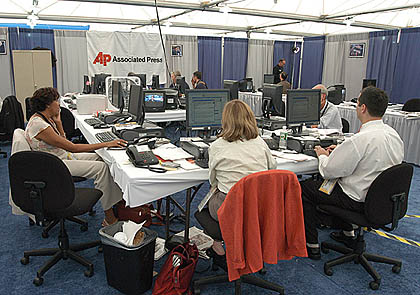


|
July 28, 2004
Front
Page
|
|
Digital Age Forces AP to Embrace
Convergence “I go with Custer and will be at the death,” was the report found on his dead body following the battle. He was never able to file his story.
If Kellogg were a reporter today, technology might not have saved his life, but it might have enabled him to send in his article. He could have filed instantly with a cell or satellite telephone and uploaded photos and video as well as sound. Today the AP, a cooperative formed in 1848 and whose members include most of the nation’s newspapers, is the largest and oldest news organization in the world with 242 bureaus. The days of telegraph and teletype are long gone. In the age of the Internet with streaming audio and video and round-the-clock news cycles, the AP has been forced to examine its operation to make sure it provides its 1,500 members, 5,000 U.S. television and radio outlets and 8,500 subscribers with news reports that meet their changing needs. "AP is very much a convergence operation,” said Sandy Johnson, AP’s Washington bureau chief, during an interview in the wire service’s high-tech space in the Democratic Convention’s press tent. “This newsroom is a convergence operation.” This make-shift newsroom really operates much like the headquarters in New York City, “with spokes that radiate out,” according to Johnson, an AP veteran of 26 years. There is a corral of tables for managers and editors in the center of the room, while each section -- text, photos, sound and video -- spokes around them, an ideal arrangement for a quick response to breaking news. "The managers from all the media that we encompass are presented in one place and can coordinate their information,” said Ed Tobias, assistant managing editor for AP Broadcast. "If APTN [AP Television News] gets an interview that nobody else in AP has, we know about it. So radio can pull audio from it; print can pull quotes from it. If print gets something, we can get the information. If photo knows something that's happening, because they have photographers everywhere, they can tip us; and if we want to, we can send somebody." Challenges remain for the AP journalists -- beyond the difficulties and dangers of finding the news. “Everyone and their brother or sister is working with some type of radio equipment in this operation, whether it be walkie-talkies, communications or radio equipment that carries an active program, or cell phones, or a wireless . . . or something,” said Tobias. He said one of the difficulties is that these technologies have the potential to interfere with each other. Still, the information carried on these frequencies “is our lifeblood.” To fulfill the needs for the various reports (visual, audio and print), AP broadcasting and print have about the same number of people covering the convention as in 2000. Decade-old AP Television increased its staff to 25. “The demand for the conventions is always big. It’s not a domestic story only. Election coverage is a world story,” explained Denise Vance, APTN’s international TV manager. “Most countries abroad see the U.S. as a superpower, so anything that happens in the electoral process is of interest to their countries at home.” The need for reports with audio, video, pictures and text is growing. “Many stations are expanding news coverage,” she said. “Some stations are going to 24/7, some stations are starting their own Web sites, so the demand for [converging] news [reports] is increasing.” The AP is more digitally oriented. “We are providing the online world with text, graphics, stills, video and audio,” Tobias said. "We're taking all of those elements and combining them into one video product for Web use.” The AP has even turned to one of its long-time correspondents, veteran political reporter Walter Mears, to join the latest wave of bloggers to enhance the wire service’s reports from the political conventions. “We should be fast enough with all of our products online that we're scooping ourselves,” said Tobias. “As AP strives to become more multi-media oriented, we are making others aware that there are many platforms on which you can receive your news,” Vance added. “We can not only provide stations with news footage, but we stream video for a broadcaster’s Web page, we provide the wires for them to write to the video, we have the graphics,” she said. “That’s the wave of the future.” |
|
|
MediaNation
TM © 2004 University of Massachusetts Boston and
Nieman Foundation at Harvard University. Legal notice
